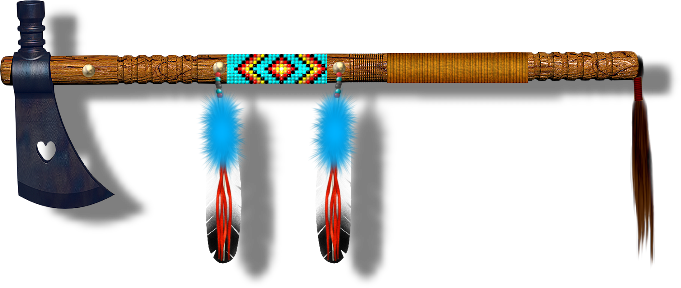
Tecumseh
1768 – 1813
Tecumseh (Shooting Star) was born in 1768, probably at Old Piqua, along the Mad River in Ohio. He was a Shawnee Indian and eventually became one of their greatest leaders. Tecumseh’s father died at the Battle of Point Pleasant during Lord Dunmore’s War in 1774. Fearing the encroaching white settlers, many Shawnees, including Tecumseh’s mother, moved westward first to Indiana, then Illinois, and finally to Missouri. Tecumseh, only eleven years old at the time, remained in the Ohio Country and was raised by his eldest brother, Chiksika, and his sister, Tecumpease. Chiksika trained Tecumseh to become a warrior. Tecumseh’s first military encounter occurred against an army led by George Rogers Clark into the Ohio Country in 1782. Tecumseh, panic-stricken, fled from the battlefield. Humiliated, he determined to never run again. Tecumseh quickly grew into a brave warrior and eventually became a Shawnee leader. He fought against the army of Arthur St. Clair in 1791. The Indians in the Northwest Territory emerged victorious. Tecumseh soon became one of the most trusted leaders of the Shawnees. Younger braves especially admired him, because of his call for violent resistance against further white settlement of native land. The Indians were not so successful against the army of Anthony Wayne in 1794. At the Battle of Fallen Timbers, Wayne’s men defeated the Native Americans, including Tecumseh. Many Indians believed relinquishing much of their land was the only way to appease the whites. Most tribes living in Ohio signed the Treaty of Greeneville in 1795. Under this agreement the Native Americans gave up all of their land except the northwestern corner of present-day Ohio. Not all Indians concurred with their tribes’ actions. Tecumseh was among them.
By the early 1800s, Tecumseh decided that the best way to stop white advancement was to form a confederacy of Indian tribes west of the Appalachian Mountains. Tecumseh believed that no single tribe owned the land and that only all tribes together could turn land over to the whites. He also believed that, if the Indians united together, they would have a better chance militarily against the Americans. Tecumseh visited most Indian tribes west of the Appalachian Mountains between Canada and the Gulf of Mexico, trying to convince them to unite together. Tecumseh’s younger brother, Tenskwatawa, the Prophet, helped Tecumseh to unite the Indians together. The Prophet had a vision where the Master of Life, the Shawnee Indians’ primary god, told him to have the Indians to give up all white customs and products. These things included religious beliefs and agricultural practices, as well as guns, iron cookware, and alcohol. The Indians, by turning their backs on their traditional ways, had offended the Master of Life. If they returned to native customs, the Master of Life would reward them by driving the whites from the land. Many natives embraced the Prophet’s message and joined the two brothers at Prophetstown, a village the two had established in 1808 in the Indiana Territory.
The governor of the Indiana Territory, William Henry Harrison, noted the growing number of Indians congregating at Prophetstown. In 1811, Harrison led an army towards the village. Tecumseh was recruiting Indian allies in the southern part of the United States. He left his brother with orders not to attack the Americans. The Prophet claimed to have received another vision from the Master of Life. In this vision, the Master of Life told him to send his warriors against the Americans. The Master of Life also purportedly said that the soldiers’ bullets would not harm the Indians. The resulting battle was known as the Battle of Tippecanoe. The Americans defeated the Prophet and his followers, and they destroyed Prophetstown. Although Harrison lost more men in this battle than the Indians, he held the ground at the end of the day. It was a victory that would eventually elect "Old Tippecanoe" to be President of the United States.
This defeat tremendously weakened Tecumseh’s Confederation. Tecumseh had already experienced difficulties in convincing tribes to put aside their traditional differences to unite as one against the Americans. Other Indians, including some Shawnees led by Black Hoof, had actually adopted white customs and had no desire to relinquish them. During the War of 1812, Tecumseh and his remaining followers allied themselves with the British. Tecumseh hoped that, if the English won, that they would return the Indians’ homeland to them. Tecumseh died at one of the most important battles of the conflict, the Battle of the Thames, in 1813. A combined English-Indian force met an American army led by William Henry Harrison. The British soldiers ran from the battlefield, leaving Tecumseh and his Indian followers to continue on their own. The Americans drove the natives from the field, and an American’s bullet killed Tecumseh.
To many, Tecumseh’s death signified the end of the United Indian resistance against the Americans. At that time, many went to Oklahoma. However, many remained in and around their homelands of Ohio. There were approximately 36 remnant families throughout Ohio, West Virginia, Kentucky, Indiana and a few other states. The Shawnee Nation United Remnant Band is a gathering of these families. To once again bring our people together so we may learn the traditions of our people and honor our forefathers as they wished us to do.
Native Americans
First People is a child friendly site about Native Americans and members of the First Nations. 1400+ legends, 400+ agreements and treaties, 10,000+ pictures, free clipart, Pueblo pottery, American Indian jewelry, Native American Flutes and more.
Native American Indian History